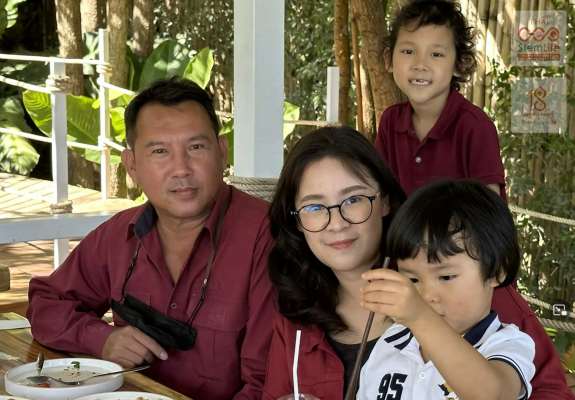You are here
Marjo and Matinn defy Thalassemia with the help of THAI StemLife and Superior ART
What is a PERFECT Family? The answer is not easy, but one common denominator for most parents, is HEALTH. This was what Marjo and Matinn’s family (https://web.facebook.com/MarjoMatinn) and 14 more families experienced when their firstborn was diagnosed with Thalassemia. Lack of health diminishes freedom of movement, restricts lifestyle and financial options, and places a family’s survival on edge. As a Thalassemic child, Marjo, today age 7 years and 9 months, was bound to a hospital, needed immediate access to blood transfusions, and required constant vigilance and treatment to avoid complications. The psychological burden on his parents was, at times, unbearable.
This is why THAI StemLife and Superior ART have, since their inception, felt the urge to help children with Thalassemia. THAI StemLife is the largest cord blood bank in Thailand and Superior ART is a leading provider of assisted reproduction technology in Thailand. Thalassemia is an inherited disorder that affects red blood cells. Southeast Asia is a cauldron of over 60 different genetic variants of hemoglobin, the protein in our red blood cells that carries life-giving oxygen. In this region, up to 70% of the population in certain areas are Thalassemia carriers, which allows a unique understanding of the complexity of this condition.
“Based on gene frequencies and number of babies born each year, it is estimated that 1.2% of babies will be born with severe cases of thalassemia each year. Further estimation revealed that 1.0% of the Thai population have thalassemia disease, which is a big health problem for the country. Curative treatment by hematopoietic stem cell transplantation (HSCT) is available but is limited to a minority of the patients”1. It is known that over 70% of patients in need of stem cell transplants will not find an HLA matching sample for a treatment, and when patients do find a match, over 80% of the matches come from within their own family2.
It is intuitive that if a family can have more children, the chance of a matching donor for the existing child with Thalassemia increases. Probability-wise, the chance that a following child will be an exact HLA match to the existing affected child is only 25%, while the probability that the following child will also carry Thalassemia is 75%. Hence, for natural conceptions, the chance of producing a sibling that can give a transplant but does not carry Thalassemia is only 18.75%. This has happened, but it requires luck to beat the odds3. Today, in-vitro fertilization (IVF) and preimplantation genetic diagnosis (PGD) with human leukocyte antigen (HLA) matching can turn these unfavorable odds into an almost 100% matching success! This is what happened with the family of Marjo and Matinn!
The mother’s persistence and the father’s unwavering support led to their inclusion in Superior ART’s IVF-PGD-HLA programme, and they also received free collection and storage of Matinn’s newborn cord blood from THAI StemLife. A couple of years later, Matinn’s wonderful cord blood stem cells were released to the treatment center, and Thailand’s 15th PGD-HLA stem cell transplant was completed during the COVID-19 pandemic. A year later, we met the elated family and celebrated Marjo’s journey to complete cure and HEALTH. Marjo’s younger brother Matinn, today age 3 years and 9 months, is the living proof of the gift of life and the epitome of how science can transform the diagnosis of Thalassemia from being a lethal verdict to an everlasting cure.
References
- Paiboonsukwong K, Jopang Y, Winichagoon P, Fucharoen S. Thalassemia in Thailand. Hemoglobin. 2022;46(1):53-7. doi:10.1080/03630269.2022.2025824
- Tiercy JM. How to select the best available related or unrelated donor of hematopoietic stem cells? Haematologica. 2016;101(6):680-7. doi:10.3324/haematol.2015.141119
- Issaragrisil S, Visuthisakchai S, Suvatte V, Tanphaichitr VS, Chandanayingyong D, Schreiner T et al. Transplantation of Cord-Blood Stem Cells into a Patient with Severe Thalassemia. New England Journal of Medicine. 1995;332(6):367-9. doi:10.1056/nejm199502093320605
- Tiewsiri K, Manipalviratn S, Sutheesophon W, Vanichsetakul P, Thaijaroen P, Ketcharoon P et al. The First Asian, Single-Center Experience of Blastocyst Preimplantation Genetic Diagnosis with HLA Matching in Thailand for the Prevention of Thalassemia and Subsequent Curative Hematopoietic Stem Cell Transplantation of Twelve Affected Siblings. BioMed Research International. 2020;2020:5292090. doi:10.1155/2020/5292090
- Kakourou G, Kahraman S, Ekmekci GC, Tac HA, Kourlaba G, Kourkouni E et al. The clinical utility of PGD with HLA matching: a collaborative multi-centre ESHRE study. Human Reproduction. 2018;33(3):520-30. doi:10.1093/humrep/dex384

